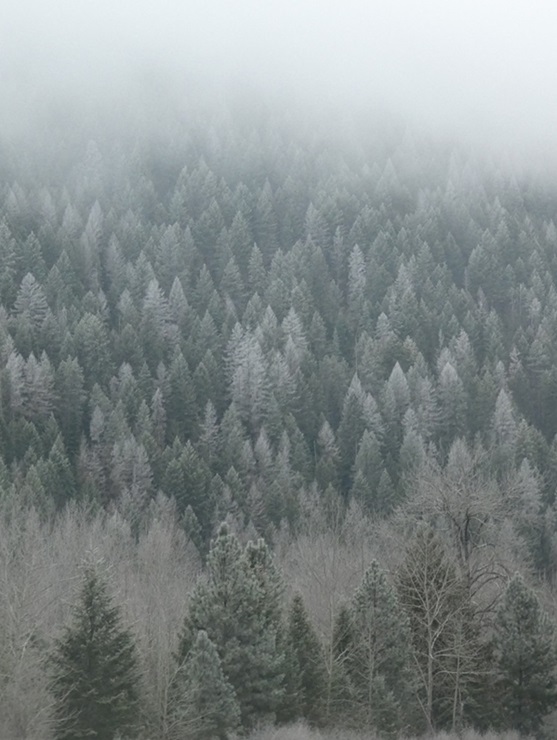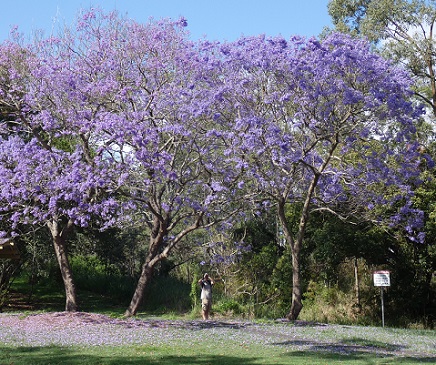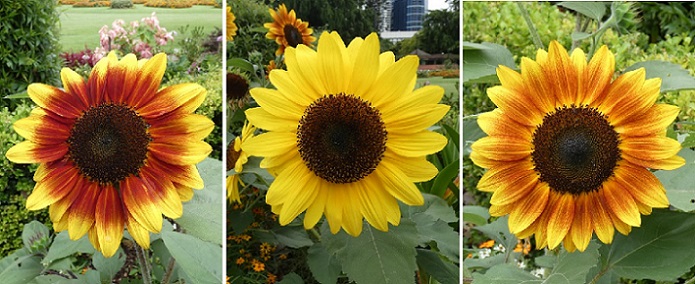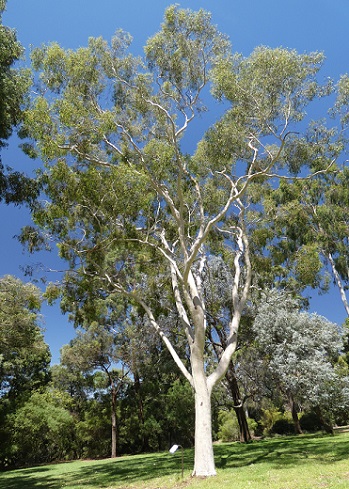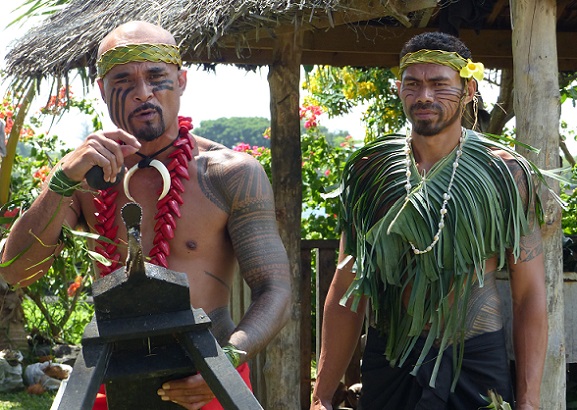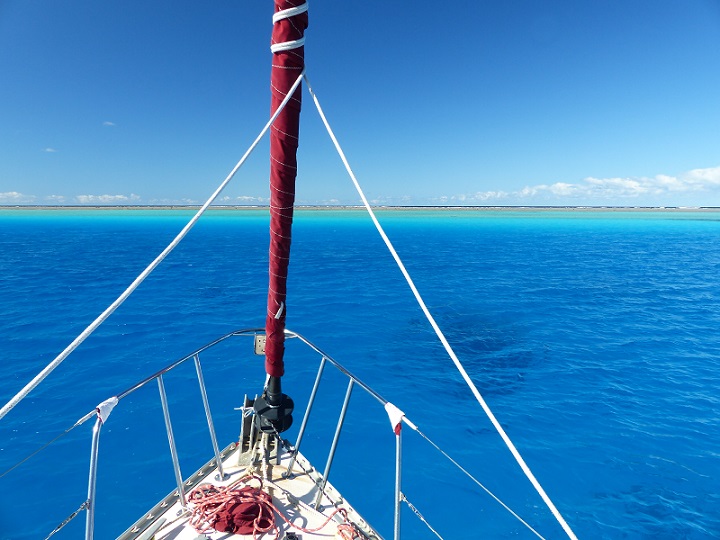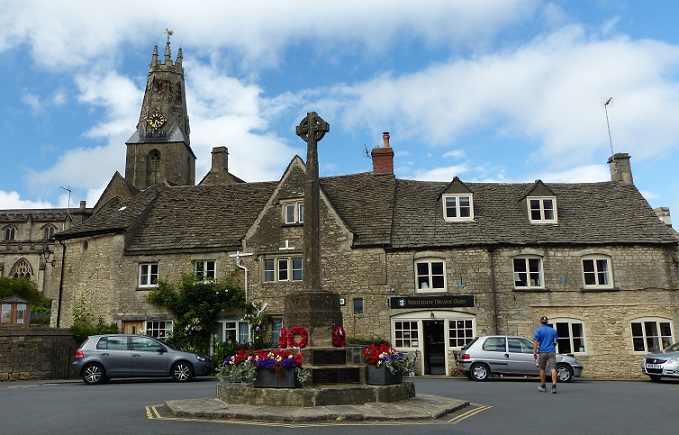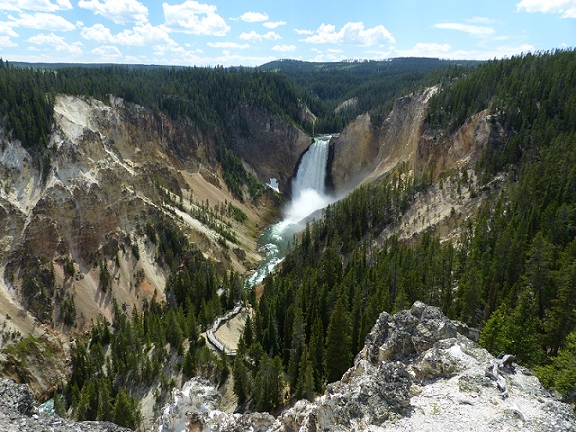
Tregoning
12 April 2024 | We are back aboard Tregoning in Mersin Marina, Mersin, Türkiye
02 April 2024 | We are in Toronto Airport, Canada: Tregoning is in Mersin Marina, Mersin, Türkiye
25 February 2024 | We are back in Gainesville, FL: Tregoning is in Mersin Marina, Mersin, Türkiye
18 February 2024 | We are in Glenwood, New Mexico: Tregoning is in Mersin Marina, Mersin, Türkiye
12 February 2024 | We are in Morro Bay, California: Tregoning is in Mersin Marina, Mersin, Türkiye
19 January 2024 | We are in Vancouver, BC Canada: Tregoning is in Mersin Marina, Mersin, Türkiye
01 January 2024 | We are in Washington State: Tregoning is in Mersin Marina, Mersin, Türkiye
15 December 2023 | We are in Minnesota: Tregoning is in Mersin Marina, Mersin, Türkiye
18 November 2023 | We are in Florida: Tregoning is in Mersin Marina, Mersin, Türkiye
29 October 2023 | We're in Florida - Tregoning is at B-dock, Mersin Marina, Mersin, Türkiye
21 October 2023 | 7 Oda Kapadokya Cave Hotel, Ürgüp, Türkiye
14 October 2023 | Hotel Aşikoğlu, Boğazkale, Türkiye
07 October 2023 | B-dock, Mersin Marina, Mersin, Türkiye
19 September 2023 | “Chez Jon & Angela”, Near Otterton, Devon, UK
14 September 2023 | Airbnb in Fortuneswell on the Isle of Portland, Dorset, UK
11 September 2023 | With Mike, Grange-over-Sands, Cumbria, UK
03 September 2023 | Ardington House, Ardington, Oxfordshire, UK
24 August 2023 | Near "Chez Joan and Peter", College of Roseisle, Moray, Scotland
11 August 2023 | Andrew's house (not exactly), Lichfield, UK
22 July 2023 | Chez Gail, near the New York Café, Budapest, Hungary
Nuku’alofa: the heart of a Kingdom
26 June 2017 | Anchorage off Big Mama’s Yacht Club, Pangaimotu, near Tongatapu, Tonga
Photo: The Royal Palace in Nuku’alofa, Tonga
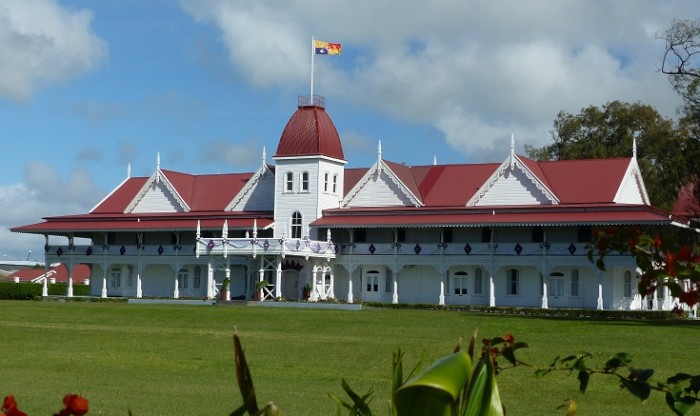
Nuku'alofa is the fifth capital city that we have sailed into during our cruising adventures, the others being: Nassau, The Bahamas; Panama City, Panama; Pape'ete, French Polynesia; and Pago Pago, American Samoa. We did not sail but drove into Kingston, Jamaica, and Wellington, New Zealand, and I flew into Mexico City from Tregoning. During our cruising hiatus in 2016 we visited Washington DC, USA, London, UK, and Reykjavik, Iceland. However, Nuku'alofa is the first place we have sailed to which is the current capital of a Kingdom (Honolulu, Hawai'i, has a former palace).
The Tongan Royal Palace is a beautiful Victorian-era building (built in 1867) on the waterfront in Nuku'alofa, surrounded by lush lawns and gardens. Refurbished in 2007-08, the building looks as though it has been well-maintained with fresh white paint, an immaculate red roof, and purple and white ribbons. The Headquarters of His Majesty's Armed Forces, including the King's Guard, fill the block to the south. The current King does not actually live in the Palace (his, presumably modern, residence is on the south coast of Tongatapu) but the building is used for formal Occasions of State.
Three blocks south of the Palace is a big grass park within the center of which are the Royal Tombs or Mala'ekula. These include plenty of statues on pedestals but with a fence all around the outside, it is not possible to get close enough to actually identify any of the tombs or memorials to members of the Royal family who have died since 1893.
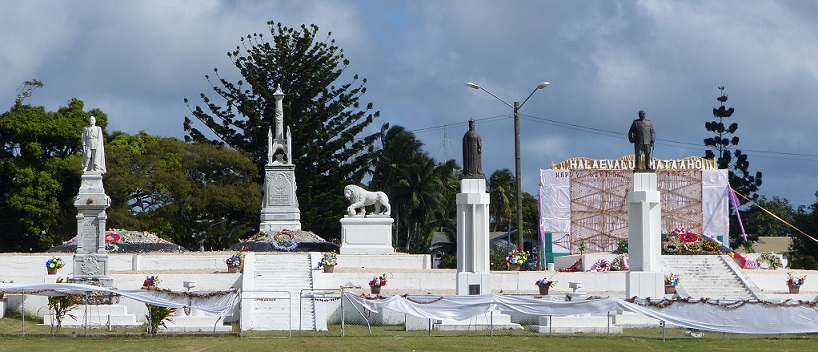
Mala'ekula or Royal Tombs
Settlement by the Lapita people in Tonga has been radiocarbon-dated from around 1100 BC. These people had voyaged from the Solomon Islands to Vanuatu around 1500 BC. After establishing the Polynesian culture in Tonga and Samoa, including their first capital at Toloa on Tongatapu, by about 200 BC they had developed sufficiently advanced ocean-going vessels to reach the Society and Marquesan Islands (now in French Polynesia). From there, they dispersed southwest to Rarotonga and the southern Cook Islands, southeast to Rapa Nui (Easter Island) in AD 300, north to Hawai'i around 400 AD, and further southwest to Aotearoa (New Zealand) in AD 900.
Around the mid-10th century AD, ´Aho'eitu became the first king of Tonga, known as the Tu'i Tonga. For the next 400 years, the Tongans were aggressive colonizers, extending their kingdom over eastern Fiji, Niue, the Samoas, and Tokelau, but the empire subsequently became fragmented as a result of civil strife and warfare. Almost 40 men have held the title of Tu'i Tonga, but after the ruling Tu'i Tonga was baptized by missionaries in 1831, he took the Christian name of George (Siaosi in Tongan), becoming King George Tupou I. By 1845, this king had united Tonga and developed the current model of government which includes a heavily Christian constitution (passed in 1875) that specifies the formats of legislative and judicial procedures (loosely based on the British model), laws for succession to the throne, a bill of rights, and rules for land tenure.
The subsequent king put Tonga under British protection (Tonga remained autonomous and independent but Britain took control over of foreign affairs and protected it from foreign attack), which was not relinquished until 1970 when King Tuafa'ahau Tupou IV re-established full sovereignty for Tonga and admission into the UN and Commonwealth of Nations. Renowned as the world's heaviest monarch at 210 kg (462 lb), he eventually became something of a role model for Tongans by shedding more than 75 kg (165 lb) in weight.
His mother had been one of Tonga's most popular monarchs, Queen Salote (Tongan for Charlotte), who was crowned at the age of 18, in 1918, and reigned for 47 years. She particularly endeared herself to the public in 1953 by taking part in the coronation procession for Queen Elizabeth II, riding bareheaded in an open carriage through the streets of London and smiling resolutely despite the pouring rain.
During World War II, New Zealand and US troops were station in Tongatapu which was a staging point for shipping in the South Pacific. In close collaboration with New Zealand, Tonga formed a local defense force of about 2,000 men who saw action in the Solomon Islands.
The current king, who succeeded his brother after the latter's sudden and unexpected death in 2012, is King Tupou VI. Although the nobles (there are 33 such titles in Tonga) still have considerable influence in Tongan government (9 out of 26 Parliamentary seats), since 2010, democracy has been taking root in Tonga with elections by the people for the remaining 17 Parliamentary seats. This swing towards democracy followed a long strike in 2005 by public servants, and riots in Nuku'alofa in 2006 which killed eight people and destroyed much of the business district.
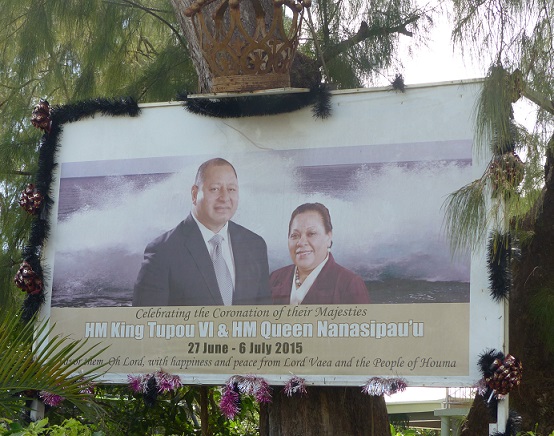
Posters featuring the King are not unusual in Nuku'alofa
Signs of the riot are now minimal with only a few concrete foundations remaining unused but there is a jumbled mix of old and new buildings. Notable buildings include the Reserve Bank of Tonga (where we exchanged some old currency from our 2015 visit to Vava'u which featured the previous king), a nice Tourist Information Center with a traditional woven roof, and numerous churches of various denominations.
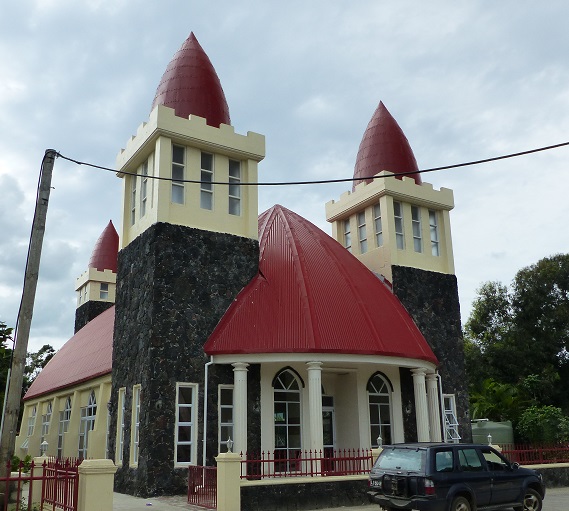
One of the more intriguing styles of church in Nuku'alofa – The Free Church of Tonga built in 2013
The large Talamahu Central Market has fruits and vegetables for sale on the ground floor and tee-shirts, other clothes, and some carvings upstairs. There are a few smaller markets scattered around the town, including a fish-market by the main wharf but we have not noticed a meat-market anywhere. There are a few small supermarkets, many tiny grocery stores and produce stands, and quite a few general stores many of which are run by people from China or India. There are a few up-market shops but hardly any stores catering to tourists, and there are many small restaurants varying from strictly local dishes to Chinese, Indian, Italian, and seafood.
No buildings appear to be more than four floors tall and one of the newest, tallest, and, in our opinion, ugliest, is the new Government Building which dominates the waterfront next to the Royal Palace. The architect tried to reflect the roof-lines of the elegant Palace but does so with clumsy, grey square tiles, an oversized red roof, and chunky white balustrades.
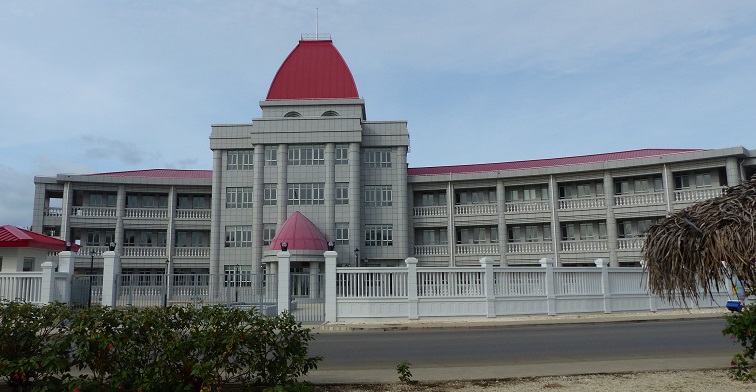
The new Government Building
This uninspiring building was erected with financial support from China which has also funded significant road improvements and public art throughout Nuku'alofa. Signs and plaques acknowledge various other internationally funded projects around Nuku'alofa including: a large expansion to the domestic ferry wharf from Japan; the Medical Officer's flash pick-up truck from Australia; "Climate change resilience" (the diagrams show some sort of breakwater) from the European Union; and solar panels from Germany. With the closing of the British High Commission in 2006, the remaining international offices in Tonga's capital are the New Zealand and Australian High Commissions, the Japanese and Chinese Embassies, and the headquarters of the US Peace Corps.
Unlike all other Pacific Islands that were at some point colonized by a European or Asian power and from whom many still receive some level of "guilt-funding", Tonga was never subjugated in this way. Thus, there is no other nation to which Tongans have rights of citizenship. While the local economy depends upon agriculture, fishing, and tourism, most external funding comes from remittances sent home by Tongans overseas (perhaps as many Tongans live outside Tonga as in it) and foreign aid, which is most evident after a natural disaster such as the impact of a cyclone.
Despite a somewhat depressed economy and the rather littered and shabby appearance of many parts of Nuku'alofa (the rickety state of the dinghy dock was not exceptional), it does not take long when walking around the town to appreciate the general friendliness and cheerfulness of the local people. There is no sense that we are unwanted intruders in their small country nor that we are seen as rich tourists to be exploited. Even the most persistent taxi-drivers and souvenir salespeople appear relaxed, smiling, and stoical in the face of a refusal to use their services or buy their wares. The overall sense of genuine congeniality of people on the street (not always of officials) reminds us of strongly of Mexico.
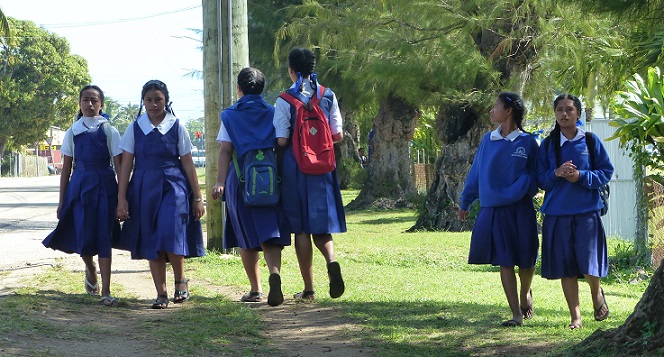
Students from Queen Salote College
Whether you pass a small barefoot child, a busy mother, a schoolgirl in a boldly colored uniform, a fisherman, or an official dressed in smart black shirt and tupenu (wrap-around cloth like the lava lava in Samoa), if you give a smile and say hello, you will undoubtedly receive a cheerful greeting in reply. Most people can speak some English, many fluently, but an interesting phenomenon is that as a greeting on the street many children will smile and quite clearly say "Bye" rather than "Hi". We have yet to find out whether this is a learning mistake, a difficulty of distinguishing B and H sounds, because a departing comment is more important than a greeting, because they want us palangi (white people) to leave, or for some other reason.
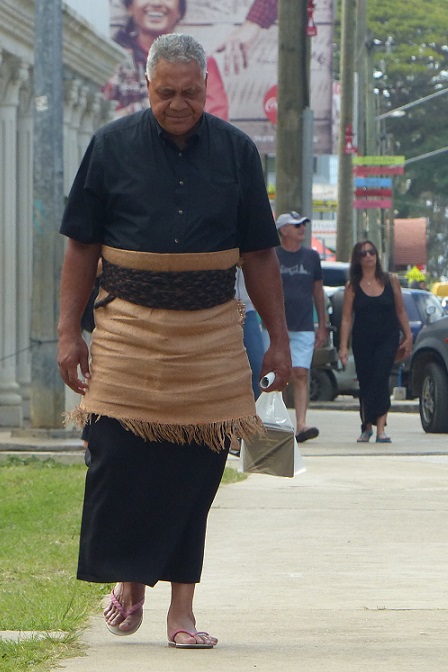
An official or office-worker in traditional black tupenu and woven ta'ovala
While many adults are big-framed and heavy (similar to Samoa) there are also many young adults who are slender and very beautiful (both women and men). Knees and shoulders are rarely visible on adults and most adult Tongans swim fully clothed. Respectfulness in dress is important and formal wear is frequently seen around town as worn by office workers. For men this includes the ta'ovala which is a mat woven from pandanus leaves and tied high around the waist over a tupenu. This tradition probably evolved from when men returned from a long voyage and cut their sail into pieces to wrap around their waists before coming ashore. Over their vala (ankle-length skirt) and kofu (tunic) or dresses, women may wear ta’ovala or, more often, they have highly decorated waistbands called kiekie. These usually consist of a woven or tapa (paper made from paper mulberry bark) belt from which hang several elaborate bands that are about 30-cm long by 4-cm wide (12 by 2 inches).
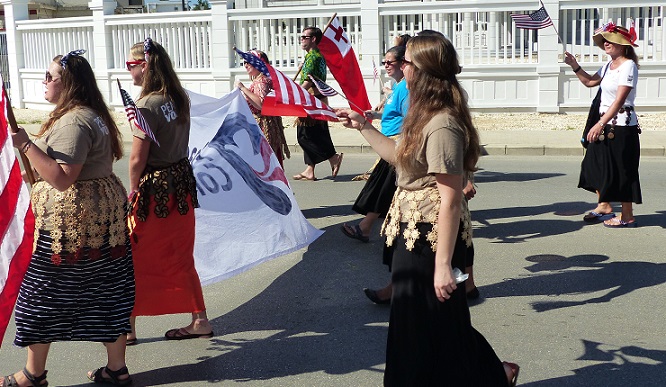
US Peace Corps workers in respectful Tongan dress including various styles of kiekie
Is it difficult to suggest that Nuku'alofa is a particularly charming town, but we are pleased that we have had the opportunity to become familiar with it and some of its 23,000 inhabitants. And how can you not like a town that’s Tongan name means “Abode of Love”? The town of Neiafu in the Vava'u Group, where we spent a few weeks in 2015, is certainly more accommodating for cruisers. But those facilities are largely run by members of the active ex-pat community there, so it does not give cruisers a very genuine flavor of Tonga. We were glad that Phil on Silhouette recommended that we spend several weeks in Tongatapu because by becoming familiar with it, we are gaining a truer sense of what it means to be Tongan...at least for those living in a relatively big town. Next, we will explore other parts of Tongatapu Island and, eventually, we will make our way out to the smaller islands and communities of this Kingdom of 171 islands.
The Tongan Royal Palace is a beautiful Victorian-era building (built in 1867) on the waterfront in Nuku'alofa, surrounded by lush lawns and gardens. Refurbished in 2007-08, the building looks as though it has been well-maintained with fresh white paint, an immaculate red roof, and purple and white ribbons. The Headquarters of His Majesty's Armed Forces, including the King's Guard, fill the block to the south. The current King does not actually live in the Palace (his, presumably modern, residence is on the south coast of Tongatapu) but the building is used for formal Occasions of State.
Three blocks south of the Palace is a big grass park within the center of which are the Royal Tombs or Mala'ekula. These include plenty of statues on pedestals but with a fence all around the outside, it is not possible to get close enough to actually identify any of the tombs or memorials to members of the Royal family who have died since 1893.

Mala'ekula or Royal Tombs
Settlement by the Lapita people in Tonga has been radiocarbon-dated from around 1100 BC. These people had voyaged from the Solomon Islands to Vanuatu around 1500 BC. After establishing the Polynesian culture in Tonga and Samoa, including their first capital at Toloa on Tongatapu, by about 200 BC they had developed sufficiently advanced ocean-going vessels to reach the Society and Marquesan Islands (now in French Polynesia). From there, they dispersed southwest to Rarotonga and the southern Cook Islands, southeast to Rapa Nui (Easter Island) in AD 300, north to Hawai'i around 400 AD, and further southwest to Aotearoa (New Zealand) in AD 900.
Around the mid-10th century AD, ´Aho'eitu became the first king of Tonga, known as the Tu'i Tonga. For the next 400 years, the Tongans were aggressive colonizers, extending their kingdom over eastern Fiji, Niue, the Samoas, and Tokelau, but the empire subsequently became fragmented as a result of civil strife and warfare. Almost 40 men have held the title of Tu'i Tonga, but after the ruling Tu'i Tonga was baptized by missionaries in 1831, he took the Christian name of George (Siaosi in Tongan), becoming King George Tupou I. By 1845, this king had united Tonga and developed the current model of government which includes a heavily Christian constitution (passed in 1875) that specifies the formats of legislative and judicial procedures (loosely based on the British model), laws for succession to the throne, a bill of rights, and rules for land tenure.
The subsequent king put Tonga under British protection (Tonga remained autonomous and independent but Britain took control over of foreign affairs and protected it from foreign attack), which was not relinquished until 1970 when King Tuafa'ahau Tupou IV re-established full sovereignty for Tonga and admission into the UN and Commonwealth of Nations. Renowned as the world's heaviest monarch at 210 kg (462 lb), he eventually became something of a role model for Tongans by shedding more than 75 kg (165 lb) in weight.
His mother had been one of Tonga's most popular monarchs, Queen Salote (Tongan for Charlotte), who was crowned at the age of 18, in 1918, and reigned for 47 years. She particularly endeared herself to the public in 1953 by taking part in the coronation procession for Queen Elizabeth II, riding bareheaded in an open carriage through the streets of London and smiling resolutely despite the pouring rain.
During World War II, New Zealand and US troops were station in Tongatapu which was a staging point for shipping in the South Pacific. In close collaboration with New Zealand, Tonga formed a local defense force of about 2,000 men who saw action in the Solomon Islands.
The current king, who succeeded his brother after the latter's sudden and unexpected death in 2012, is King Tupou VI. Although the nobles (there are 33 such titles in Tonga) still have considerable influence in Tongan government (9 out of 26 Parliamentary seats), since 2010, democracy has been taking root in Tonga with elections by the people for the remaining 17 Parliamentary seats. This swing towards democracy followed a long strike in 2005 by public servants, and riots in Nuku'alofa in 2006 which killed eight people and destroyed much of the business district.

Posters featuring the King are not unusual in Nuku'alofa
Signs of the riot are now minimal with only a few concrete foundations remaining unused but there is a jumbled mix of old and new buildings. Notable buildings include the Reserve Bank of Tonga (where we exchanged some old currency from our 2015 visit to Vava'u which featured the previous king), a nice Tourist Information Center with a traditional woven roof, and numerous churches of various denominations.

One of the more intriguing styles of church in Nuku'alofa – The Free Church of Tonga built in 2013
The large Talamahu Central Market has fruits and vegetables for sale on the ground floor and tee-shirts, other clothes, and some carvings upstairs. There are a few smaller markets scattered around the town, including a fish-market by the main wharf but we have not noticed a meat-market anywhere. There are a few small supermarkets, many tiny grocery stores and produce stands, and quite a few general stores many of which are run by people from China or India. There are a few up-market shops but hardly any stores catering to tourists, and there are many small restaurants varying from strictly local dishes to Chinese, Indian, Italian, and seafood.
No buildings appear to be more than four floors tall and one of the newest, tallest, and, in our opinion, ugliest, is the new Government Building which dominates the waterfront next to the Royal Palace. The architect tried to reflect the roof-lines of the elegant Palace but does so with clumsy, grey square tiles, an oversized red roof, and chunky white balustrades.

The new Government Building
This uninspiring building was erected with financial support from China which has also funded significant road improvements and public art throughout Nuku'alofa. Signs and plaques acknowledge various other internationally funded projects around Nuku'alofa including: a large expansion to the domestic ferry wharf from Japan; the Medical Officer's flash pick-up truck from Australia; "Climate change resilience" (the diagrams show some sort of breakwater) from the European Union; and solar panels from Germany. With the closing of the British High Commission in 2006, the remaining international offices in Tonga's capital are the New Zealand and Australian High Commissions, the Japanese and Chinese Embassies, and the headquarters of the US Peace Corps.
Unlike all other Pacific Islands that were at some point colonized by a European or Asian power and from whom many still receive some level of "guilt-funding", Tonga was never subjugated in this way. Thus, there is no other nation to which Tongans have rights of citizenship. While the local economy depends upon agriculture, fishing, and tourism, most external funding comes from remittances sent home by Tongans overseas (perhaps as many Tongans live outside Tonga as in it) and foreign aid, which is most evident after a natural disaster such as the impact of a cyclone.
Despite a somewhat depressed economy and the rather littered and shabby appearance of many parts of Nuku'alofa (the rickety state of the dinghy dock was not exceptional), it does not take long when walking around the town to appreciate the general friendliness and cheerfulness of the local people. There is no sense that we are unwanted intruders in their small country nor that we are seen as rich tourists to be exploited. Even the most persistent taxi-drivers and souvenir salespeople appear relaxed, smiling, and stoical in the face of a refusal to use their services or buy their wares. The overall sense of genuine congeniality of people on the street (not always of officials) reminds us of strongly of Mexico.

Students from Queen Salote College
Whether you pass a small barefoot child, a busy mother, a schoolgirl in a boldly colored uniform, a fisherman, or an official dressed in smart black shirt and tupenu (wrap-around cloth like the lava lava in Samoa), if you give a smile and say hello, you will undoubtedly receive a cheerful greeting in reply. Most people can speak some English, many fluently, but an interesting phenomenon is that as a greeting on the street many children will smile and quite clearly say "Bye" rather than "Hi". We have yet to find out whether this is a learning mistake, a difficulty of distinguishing B and H sounds, because a departing comment is more important than a greeting, because they want us palangi (white people) to leave, or for some other reason.

An official or office-worker in traditional black tupenu and woven ta'ovala
While many adults are big-framed and heavy (similar to Samoa) there are also many young adults who are slender and very beautiful (both women and men). Knees and shoulders are rarely visible on adults and most adult Tongans swim fully clothed. Respectfulness in dress is important and formal wear is frequently seen around town as worn by office workers. For men this includes the ta'ovala which is a mat woven from pandanus leaves and tied high around the waist over a tupenu. This tradition probably evolved from when men returned from a long voyage and cut their sail into pieces to wrap around their waists before coming ashore. Over their vala (ankle-length skirt) and kofu (tunic) or dresses, women may wear ta’ovala or, more often, they have highly decorated waistbands called kiekie. These usually consist of a woven or tapa (paper made from paper mulberry bark) belt from which hang several elaborate bands that are about 30-cm long by 4-cm wide (12 by 2 inches).

US Peace Corps workers in respectful Tongan dress including various styles of kiekie
Is it difficult to suggest that Nuku'alofa is a particularly charming town, but we are pleased that we have had the opportunity to become familiar with it and some of its 23,000 inhabitants. And how can you not like a town that’s Tongan name means “Abode of Love”? The town of Neiafu in the Vava'u Group, where we spent a few weeks in 2015, is certainly more accommodating for cruisers. But those facilities are largely run by members of the active ex-pat community there, so it does not give cruisers a very genuine flavor of Tonga. We were glad that Phil on Silhouette recommended that we spend several weeks in Tongatapu because by becoming familiar with it, we are gaining a truer sense of what it means to be Tongan...at least for those living in a relatively big town. Next, we will explore other parts of Tongatapu Island and, eventually, we will make our way out to the smaller islands and communities of this Kingdom of 171 islands.
Comments
| Vessel Name: | Tregoning |
| Vessel Make/Model: | Morgan Classic 41 |
| Hailing Port: | Gainesville, FL |
| Crew: | Alison and Randall |
| About: | We cast-off from Fernandina Beach in north Florida on 1st June 2008 and we have been cruising on Tregoning ever since. Before buying Tregoning, both of us had been sailing on smaller boats for many years and had worked around boats and water throughout our careers. |
| Extra: | “Tregoning” (rhymes with “belonging”) and is a Cornish word (meaning “homestead of Cohnan” or “farm by the ash trees”) and was Alison's mother’s middle name. Cornwall is in southwest England and is where Alison grew-up. |
Tregoning's Photos - Main
 |
Extra photographs from our three-week campervan tour of the South Island from November 15th to December 5th 2015
217 Photos
Created 4 January 2016
|
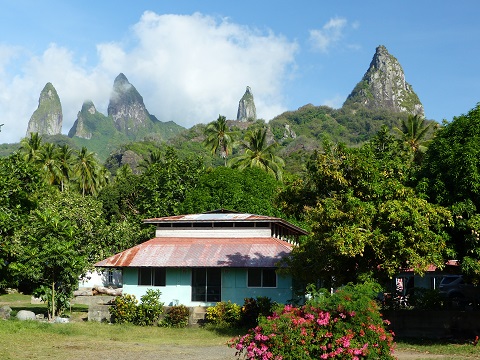 |
Random pictures from our month spent on the islands of Hiva Oa, Tahuata, Ua Pou, and Nuku Hiva
45 Photos
Created 18 July 2015
|
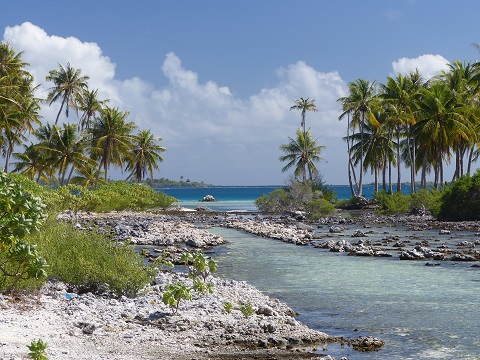 |
Random pictures from our month spent in 4 Tuamotu Atolls; Ahe, Fakarava, Tahanea, and Toau
32 Photos
Created 1 July 2015
|
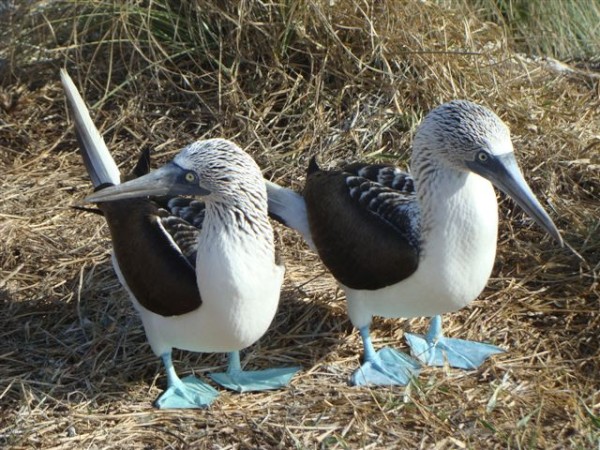 |
Some of the birds, fish, reptiles, and mammals (and others) that we have seen in Mexico
74 Photos
Created 5 May 2014
|
Tregoning

Who: Alison and Randall
Port: Gainesville, FL
